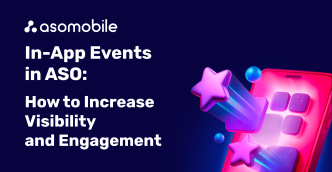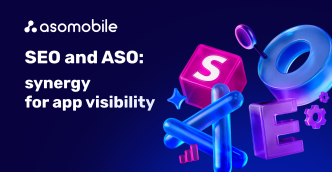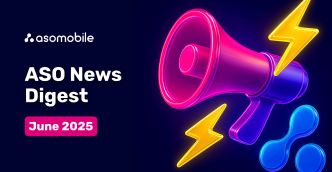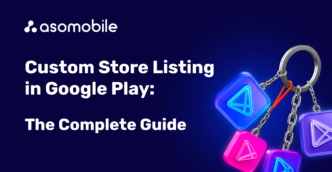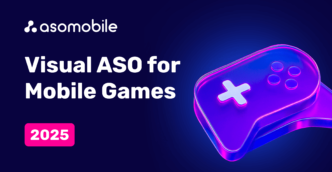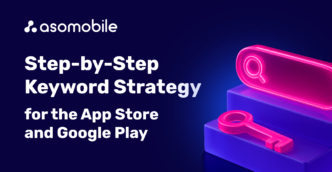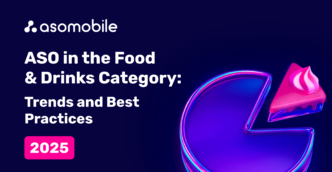ASO Dictionary
ASO Dictionary from ASOMobile contains the basic terms and concepts in the ASO optimization of mobile apps. All terms are situated in alphabet order.
ASO (App Store Optimization) is the process of improving the visibility of an app in stores. Includes work with text and visual parts of the app. ASO optimization helps to attract more visitors to the app page and turn them into users.
ASO Tools help you find relevant keywords, prioritize search queries, compose adequate metadata, and analyze keyword rankings.
ASOMobile is a mobile app analytics platform.
App visibility is how much a market or store displays you in search results. The number of indexed queries and how high the application is displayed in the search results are considered.
ASO audit is a procedure for assessing the quality of optimizing the application page on the market.
App Store is the official iPhone, iPad, and Apple Watch application store.
Android is a mobile operating system developed by Google on a modified version of Linux.
Advertising traffic is paid advertising within a store or market. Also, unmotivated traffic includes app installs that follow the classic advertising model: users notice an app ad that is interesting to them and go to the link.
Application page is a page on the application store where information about the application is placed: name, description, icon, screenshots, rating, reviews, and developer's name. Users come here from search results, recommendations, editorials, and top charts or via a direct link.
A/B tests - test text and visual ASO to select the most successful texts and creatives. Users are divided into groups, and each group is shown different icons, screenshots, descriptions, titles, and subheadings (for example, old and updated versions). The results are compared and help to select which option of the data users reacted best.
Apple Search Ads (ASA) is an advertising tool for promoting mobile applications on the App Store by keywords (user queries).
API is an application programming interface, a set of protocols, methods, functions, or commands that programmers use to develop software products or speed up system interactions.
At the end of the article, you can find a 40% discount coupon for the first month of using ASOMobile - a tool for creating ASO and researching competitors in the mobile app market.
Benchmarks are the average scores of apps in Google Play and App Store categories regarding the ratio of views and clicks to installs (average conversion).
Collections (Similar Apps) is a list of apps that are similar in topic. The collections are formed based on the internal algorithms of the app markets.
Creatives are all visual elements that appear on a product page on the App Store or Google Play.
Direct occurrence is a key phrase in the text in its original (unchanged) form (singular, plural, etc.).
Developer is a person or company that develops and publishes applications. Typically, the developer and publisher of the application are the same person (company).
Description (full description) on Google Play is a description of the main functions and features of the application, as well as information about the benefits it can bring to the user. The description is indexed, so it is advisable to include keywords to help the user find the application.
Featuring means all apps and games selected for the Today, Games, and Apps tabs. Typically, apps that get featured get a lot of new users and installs.
Google Play is an official app store by Google where users can download and purchase apps, music, movies, books, and periodicals.
Google Natural Language is a set of tools for analyzing and parsing text through syntactic analysis.
Indexing is the visibility of an app by keywords on Google Play or the App Store. When a keyword indexes an app, the user can find it by entering this keyword into the search.
iOS is an operating system developed by Apple to support mobile apps for iPhone, iPad, and Apple Watch.
Indie developer is a specialist who develops games and applications independently or is part of a small development team for mobile applications without financial support from large companies.
Icon is an image of an application used in search results and on the device screen. Usually, they try to display the main task of the application on the icon (for example, if that is the application with recipes, an icon shows kitchen utensils or food).
Keyword (search query, key, keyword) is a word or phrase that characterizes the application or its primary functions. Users type these words and queries in the search to find the application they are interested in. Developers are trying to embed them in metadata to improve the visibility of the application in search.
Keyword's frequency (traffic) is the number of users who enter a given search query into the market's search bar for a certain period (usually a day). The higher the frequency, the more popular the request.
Keyword phrase is a combination of keywords that helps developers promote their app to their target audience.
Keywords field (in the App Store Connect developer console) is for entering keywords that best describe the application or key function. The keyword field is only available on the App Store. This part of the metadata is hidden from the user (only the developer can see it). Filling in the keywords field in App Store Connect is one of the stages of ASO optimization to improve app visibility on the App Store. The length of the keywords field for one locale is 100 characters. Keywords in this field should be entered separated by commas (not phrases), without spaces.
Long-tail keywords are keyword phrases made up of three or more words.
Localization is the translation and adaptation of an app to other countries and languages.
Mobile application is software designed for tablets, smartphones, and portable devices.
Motivated traffic means an installation that users get rewarded for. They are motivated to complete the installation of the application. Users can make installations by keyword to grow the application by a specific request, by a direct link, by a tracking link, write positive reviews, and perform other tasks.
Metadata is application data used to increase its visibility in stores: title, subtitle, keywords (App Store), short and long descriptions (Google Play), screenshots, banners, and videos.
Name (Google Play) is the name of your app. The keywords in the title affect the visibility of the application most of all. The available name length on Google Play is 50 characters.
Organic traffic goes to an app page from search results, recommendations, editorials, and top charts. In addition, App Store users have access to a separate Trending Searches screen - the top of the most popular searches.
Publisher is a mobile app production firm that helps release the app.
Position (by keyword) means finding an app in the app store's search results when you enter a specific search query.
Release is the publication of a new version of an app on the app store.
Relevance (in the context of keywords) is a keyword's correspondence to the application's functionality. How accurately does it describe the idea of a mobile application?
Rating is a rating from 1 to 5 that users give based on their experience with the application.
Reviews are feedback from app users. Each review is rated (1 to 5 stars) and is published on the app store. The review cannot be deleted or redone. It will be available to everyone until the user deletes or changes it.
Subtitle (App Store) is the metadata that appears below the title and is 30 characters long. Subtitle keywords have slightly less search engine weight than title keywords, but this field must also be optimized.
Short description (Google Play) is part of the app metadata. The short description includes 80 characters and is needed to attract visitor's attention to the application page, so it is advisable to use a Call to action. This field is indexed and needs to be optimized to improve the visibility of the application.
Spamming is too frequent mentioning of a keyword in the app description text.
Stop words are words that the App Store ignores. We recommend that you avoid using them when generating application metadata. Stopword list: a, about, above, after, again, against, all, am, an, and, any, app, are, aren't, as, at, be, because, been, before, being, below , between, both, but, by, can't, cannot, could, couldn't, did, didn't, do, does, doesn't, doing, don't, down, during, each, few, for , from, further, had, hadn't, has, hasn't, have, haven't, having, he, he'd, he'll, he's, her, here, here's, hers, herself, him, himself , his, how, how's, i, i'd, i'll, i'm, i've, if, in, into, is, isn't, it, it's, its, itself, let's, me, more , most, mustn't, my, myself, no, nor, not, of, off, on, once, only, or, other, ought, our, ours, ourselves, out, over, own, same, shan't , she, she'd, she'll, she's, should, shouldn't, so, some, such, than, that, that's, the, their, theirs, them, themselves, then, there, there's, these, they , they'd, they'll, they're, they've, this, those, through, to, too, under, until, up, very, was, wasn't, we, we'd, we'll , we're, we've, were, weren't, what, what's, when, when's, where, where's, which, while, who, who's, whom, why, why's, with, won't, would, wouldn't, you, you'd, you'll, you're, you've, your, yours, yourself, yourselves.
Screenshot (visual ASO): screenshots of the main functions of the application, which are placed on the application page to show the user all the benefits and increase the conversion. The screenshots give the user an opinion about the app and how he will use it. You can upload ten screenshots on the App Store and eight on Google Play.
Suggestions are search suggestions that the market offers based on popular user queries. Search terms that are in the suggestions usually have more traffic.
Search Ads: the popularity of a search query in Apple Search Ads. Values range from 5 (unpopular) to 100 (very popular).
SERP is a search results page on an app store. If a user searches for a specific query, the search results page will show a list of suitable apps, starting with the most popular and advertising.
Short-tail keywords are keywords or phrases of no more than two words.
Semantic core is an array of keywords and phrases that best describe the application of all relevant associations. ASO specialists embed this key list in metadata to improve the visibility of the application in search (ASO optimization). The user can find the optimized application by entering these keywords in the market search.
Text ASO is the process of optimizing the metadata of an application to improve its visibility in search.
Title (App Store) is the name of your application. The title, most of all, affects the visibility of the application, so it is advisable to add relevant search queries to the title. In the App Store, the name is 30 characters long.
Trending searches are this hour's four most popular searches on the App Store.
Top charts list the most popular apps in a certain period (free, paid, cash-based).
Visual ASO is the process of optimizing the visual elements of the application page: icons, screenshots, and video.
 Українська
Українська  Русский
Русский  Español
Español 